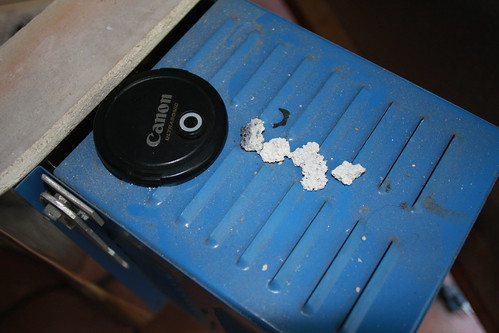 |
| Moon Rocks! |
 |
| Next to the lens cap for some scale |
 |
| Some of the bigger chunks |
I decided to take it to a cone firing at that point. I reset the controller for I think cone 05 or 06. I wanted to at least get the organics burned off.
About an hour later it was at 900. I peeked in again. It had begun to collapsed. Most of the black had gone away. I think at that point I let it go for another few hundred degrees. It was at about 1100 - 1200 that I opened it up again and shut it down. While there was a lot of white, it had fallen apart at this point and there was a glowing red core in the middle of the pile. I could see through a hole in the pile. Looked very volcanic.
So now I am drying the slabs I made. I'm going to see if drying them at 160 degrees F will make a difference.
I think the seeds are a bust. Big holes in the matrix may not leaving enough clay to stabilize the structure during the burn off. This has got to be leading to concentrations of stress and then crack propagation. It was also suggested that the seeds may be expanding during the process and there's a thought that the high oil content may be creating too much hot gas too fast.
Two other things missing in my mix are a larger aggregate and a flux. The chunks from this run can be used as a grog. If the other slabs bite the dust, they can be grog too. The other option is to get some silica sand.
For my next trick, I am going to go to small batches with different mixes. All will be with way less water and some slake time. "Frosty" at iforgeiron.com made a whole bunch of suggestions about how to mix it.
I'm thinking this for trials:
- Clay blend but with sawdust
- Clay blend with flux and seeds
- Clay, flux, and sawdust
- Clay, flux, seeds
- Clay, silica sand, sawdust
- Clay, silica sand, seeds
- Clay, silica sand, flux, sawdust
- Clay, silica sand, flux, seeds
- Clay, grog, sawdust
- Clay, grog, seeds
- Clay, grog, flux, sawdust
- Clay, grog, flux, seeds
I have to research what to use for a flux. Fluxes are elements or compounds that cause other elements or compounds to flow, generally at lower temperatures. Some also drive off impurities. Soldering flux is what most of us are used to.
An example is boron & silica. Pure silica will not melt until something near 3000 degrees F. Throw in a little boron and that drops to the 1300 deg. F range. I don't think boron is a true flux in this case as it sticks around.
I'm going to go 2 - 3 at a time so I learn something as I go and hopefully I can adjust and close on a successful formula faster. So ... time to break out the spreadheet and do some math.
Oh ... I found perlite at Home Depot. So that's going to go in here someplace too. A reportedly successful castable mix is to use refractory mortar mixed with perlite. I have some Sairset mortat. So, I may try a small batch of that with perlite in the first run too.
Meanwhile the slabs are in the kiln at 160 F for a couple more days I s'pect.
No comments:
Post a Comment